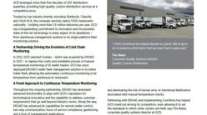Class 8 Truck Fleet Dips 1.2% as Firms Purge Older Models
This story appears in the May 30 print edition of Transport Topics.
U.S. truck owners registered more heavy-duty vehicles in the year’s first quarter than a year earlier, but also purged older trucks at an even faster rate, causing the nation’s Class 8 fleet size to drop for the fifth time in the past six quarters.
Registrations of new trailers also declined.
R.L. Polk & Co. said May 19 there were 3.52 million heavy trucks in operation at the end of March, a 1.2% decline from the 3.56 million registered nationwide 12 months earlier.
The Southfield, Mich., research firm also said heavy-duty registrations grew at a much more tepid pace during the quarter than did U.S. retail sales, opening up a larger-than-usual gap.
“The strong reported order flow and resultant high retail sales — as reported in news and trade sources . . . have yet to be reflected in significantly higher new registrations of gross vehicle weight Class 8 vehicles,” Polk said.
There is a 17% gap between sales and registrations, whereas 5% is typical by historical standards, said Gary Meteer Sr., the account director for the Southfield, Mich., firm’s commercial vehicle group.
Polk said first-quarter U.S. heavy-duty registrations rose by 2.2%, year-over-year. In contrast, first-quarter retail sales, as measured by WardsAuto.com, expanded by 34% during the same period.
One possible source for the gap, Meteer said, is growing export sales. Data from ACT Research Co. say exports of heavy-duty trucks built in North America and sold to the rest of the world has more than doubled to 6,574 heavy trucks during the year’s first four months from 2,799 vehicles during the same time in 2010.
In analyzing vehicle age, the Polk report said 149,000 pre-2000 commercial vehicles, Classes 3-8, were retired during the January-through-March period. Including all of 2010, 503,000 older trucks have been disposed of over the past five quarters.
Trucks made from 2000 to the present are now 54.4% of the nation’s total fleet, Polk said, but in 2009 there was a 50-50 split.
The report also said registrations of new trailers went through a dramatic turnaround, dropping 15.9% to 18,038 units for the quarter. In contrast, the total shot up by 42% during last year’s fourth quarter.
The exception was the registrations of new intermodal container chassis, which expanded 400% to 1,077 units from 209 in last year’s first quarter. Meteer said Hyundai Translead manufactured more than 90% of them.
“A year ago the market was soft but not terrible. Now, though, it’s pretty good, considerably better,” said Glenn Harney, chief sales officer of the San Diego-based manufacturer.
Ocean lines, mindful of new safety regulations on chassis, are considering abandoning their role as providers of the equipment. Therefore, Harney said, other owners of chassis, including trucking companies, are preparing for possible changes.
“There are very few new entrants to chassis buying, but there is uncertainty about steamship lines, so other companies are stepping up, especially with the economy improving,” Harney said.
Polk’s report also found that dry and refrigerated van registrations fell by 39.1% and flatbeds dropped 20.4% during the first quarter.
Hyundai also makes van trailers, and Harney said much of his January-to-March production went to dealers seeking to replenish inventories. He said his backlog of unbuilt orders is now about four months, whereas in 2009 it was less than two months.
“This is a much better situation,” he said.
Meteer said the first-quarter report overstates any problems trailer makers might have, just as the fourth-quarter surge overstated prosperity.
“It’s somewhere in between. There were some timing issues with February being a very bad month,” Meteer said.
Registrations for lighter weight trucks grew more rapidly than did the heavier weight classes. Class 3 grew the most, with 36.6% more registrations than the year-ago quarter, with most of the production coming from the Michigan-based manufacturers: Chrysler, Ford and General Motors.
Classes 4 and 5 grew by about 17.5% each.
In contrast, registrations for new Class 6 trucks grew by 3%, year-over-year, similar to the 2.2% growth in Class 8.
Class 7 was the only grouping to post a decline in new registrations, dropping 25.8%. Meteer said buses for schools and other purposes usually make up more than 30% of Class 7 registrations, and sales of those vehicles have been slashed drastically due to local government budget crises.
Meteer said two segments of Class 8 doing particularly well are general freight and leasing/renting — the two groups connected most directly with freight transportation. Class 8 applications for agriculture, farming and construction are declining, he said.
“We’re not in a broad expansion mode yet. What we have seen come back is a narrow group of vehicles,” he said.



